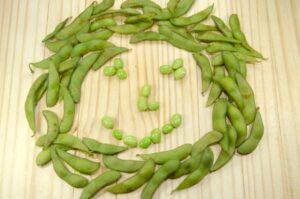Mukimame vs Edamame: Comparing Nutrition and Uses
Exploring the world of soybeans reveals a variety of options, two of which are mukimame and edamame. These terms can be confusing since both refer to the same type of soybean. Edamame are young soybeans still in their pods, traditionally enjoyed in Japanese cuisine as a snack or appetizer. They are often steamed and lightly salted to enhance their natural, slightly sweet and nutty flavor. Mukimame, on the other hand, are shelled edamame, presenting the beans without their outer pods, making them a convenient and versatile ingredient in an array of dishes.

In terms of nutrition, both mukimame and edamame are protein-rich and serve as excellent sources of fiber and essential vitamins and minerals. The key difference lies in their culinary uses. While edamame is commonly consumed by squeezing the beans out of the pod directly into the mouth, mukimame is ready for direct use in various recipes from salads to stir-fries. Although both can be found in frozen form, their preparation methods vary slightly to preserve taste and texture.
Key Takeaways
- Edamame are podded soybeans often enjoyed as a snack, whereas mukimame comes shelled for immediate use.
- Both forms boast high protein, fiber, and valuable nutrients suitable for various diets.
- Proper storage and cooking methods are essential to maintain the distinctive taste and quality of edamame and mukimame.
Nutritional Profiles of Mukimame and Edamame

Mukimame vs edamame are nutritionally similar foods, both offering a wealth of nutrients that are beneficial to any diet. They are an excellent source of protein, fiber, vitamins, and minerals with relatively low caloric values.
Protein Content and Quality
Both mukimame vs edamame are high in protein, which is essential for muscle repair and growth. A serving of edamame delivers around 17 grams of protein, making it a great protein source for vegetarians and vegans alike. Mukimame offers the same quality of protein since it is simply the shelled version of edamame.
Vitamins and Minerals
Edamame and mukimame are rich in vitamins and minerals, such as folate and vitamin K. They are also a good source of calcium and iron, which are critical for bone health and oxygen transport in the blood, respectively.
- Folate: Essential for DNA synthesis and repair.
- Vitamin K: Important for blood clotting and bone health.
A single serving of these beans can provide a substantial amount of the recommended daily intake for these nutrients.
Dietary Fiber Comparisons
The dietary fiber content in both edamame vs mukimame is high, which can help with digestive health and provide a feeling of fullness. While the fiber content remains largely the same whether the beans are shelled or in the pod, the convenience of mukimame might make it a more accessible choice for a quick fiber boost.
Caloric Values
When considering caloric values, edamame vs mukimame are both low-calorie options that can fit well into a calorie-conscious diet. A serving of edamame contains approximately 188 calories, whereas mukimame has a similar calorie count, providing both an energy boost without the burden of high calories.
For those concerned with the flavor profile of their edamame, the sucrose and alanine contents of edamame beans can be of significant interest, as these compounds directly affect the sweetness of edamame. This genetic understanding underlines the potential to enhance the taste through selective breeding, giving rise to varieties that may differ slightly in nutritional composition.
Culinary Uses and Recipes
In my experience, both edamame vs mukimame offer versatile options in the kitchen. Edamame, typically enjoyed in the pod, and mukimame, the shelled counterpart, both adapt well to a variety of cooking techniques and recipes.
Cooking Techniques
Edamame is often boiled or steamed in its pod and served with a pinch of salt, providing a rustic and satisfying snack. Its firm texture holds up perfectly against the heat, making it a great addition to Asian cuisine. On the other hand, mukimame is more suited for recipes where only the bean is needed. The absence of a pod means mukimame cooks slightly faster and is a time-saver in dishes such as stir-fries or salads.
Recipe Ideas
Here’s a brief table outlining a few recipe ideas for both edamame vs mukimame:
| Edamame Recipes | Mukimame Recipes |
|---|---|
| Salted edamame pods | Mukimame and avocado salad |
| Edamame hummus | Mukimame stir-fry with tofu and veggies |
| Edamame soup | Quinoa salad with mukimame |
Each recipe brings out the natural, nutty flavor of the soybean and complements different meal types.
Incorporating Into Meals
Edamame serves as a fantastic side dish or snack due to its texture and ease of preparation. I find it particularly enjoyable when incorporated into sushi rolls or mixed into a warm bowl of soup. Mukimame, with its more accessible, pod-free nature, can become the protein-rich star of a salad or add a pop of color and flavor to a stir-fry. Both beans are excellent at absorbing flavors, making them highly adaptable to various recipes and cuisines.
Differences Between Mukimame and Edamame

Exploring the distinctions between mukimame and edamame reveals variations in flavor and texture, as well as differences in their physical form and maturation process.
Texture and Flavor Variations
Mukimame and edamame differ notably in texture. Mukimame, shelled edamame, tends to have a softer feel, especially after cooking. Concerning flavor, while edamame has a light, buttery taste with a slight nuttiness, mukimame can showcase a stronger, more pronounced flavor akin to green peas.
Physical Attributes
The primary difference in physical attributes between the two is apparent: edamame is the whole, green pod containing immature soybeans, while mukimame is the name for the beans alone, extracted from their pods. This distinction is particularly significant as the presence of the pod in edamame can affect both texture and taste.
Maturity and Harvesting
In terms of maturity and harvesting, edamame beans are harvested while the beans are still young and soft, hence classifying them as immature soybeans. Mukimame, being the same beans, is similarly picked at this stage of maturity; however, it is immediately shelled before packaging. Quantitative texture analysis of legumes like edamame provides insight into the ideal firmness and quality sought after in these products.
Health Benefits and Dietary Considerations

When comparing mukimame to edamame, it’s crucial to consider their impact on weight management, support for plant-based diets, and the benefits they offer for bone health and essential nutrients. Both these soybean forms are not only excellent for various dietary needs but also provide significant health benefits.
Weight Management
Mukimame and edamame are both low in calories yet high in fiber and protein, which can help with weight control. The dietary fiber keeps you satiated, potentially reducing overall calorie intake. As a complete protein, they provide all essential amino acids your body needs, making them a great food choice for those who are tracking their weight.
Plant-Based Diets
For individuals following vegetarian or vegan diets, both mukimame and edamame offer significant nutritional benefits. They serve as vital sources of plant-based protein, crucial for maintaining muscle and overall health. Their role in a plant-based diet is indispensable due to their versatility and nutrient density.
Bone Health and Nutrients
Both types of soybeans are packed with nutrients that support bone health. They contain calcium, magnesium, and other vital minerals that are essential for maintaining strong bones. Mukimame and edamame also contribute to your recommended daily intake of vitamins, such as Vitamin K, which is important for bone metabolism.
Storage and Preparation Tips

To maintain their freshness and flavor, both mukimame and edamame require specific storage conditions. I’ll outline the best techniques for doing so and offer straightforward methods for preparation and serving.
Storing for Freshness
- Edamame: Store uncooked edamame in the pod in a plastic bag in the refrigerator for up to one week. If I need to store them longer, I freeze the pods in airtight bags for up to six months.
- Mukimame: Since they’re shelled, mukimame beans dry out faster. I refrigerate them for no more than a few days. For extended storage, I freeze them in airtight containers, just like edamame.
Preparation Techniques
- Edamame: I boil edamame pods in saltwater for about 5 minutes or steam them for up to 10 minutes. Then, I rinse them under cold water to enhance their green color.
- Mukimame: These beans are already shelled, so I can cook them faster by boiling for just 2-3 minutes or microwaving them with a bit of water.
Quick and Easy Serving Ideas
For a simple snack, I like to toss boiled edamame pods with sea salt and serve them warm. Mukimame are more versatile—they can be added to salads, rice dishes, or stirred into soups for an extra protein boost.
Frequently Asked Questions

In this section, I cover common queries about the differences in nutritional content, taste profiles, and recipes regarding mukimame and edamame, along with their distinctive health benefits and a comparison to other beans.
What distinguishes mukimame from edamame in terms of nutritional content?
Mukimame and edamame are both immature soybeans, but their nutritional content can vary slightly depending on how they are prepared and served. Mukimame, often shelled, may have a slightly different nutrient ratio due to the absence of the pod.
How do the flavors of mukimame and edamame compare?
The flavor of mukimame tends to be robust and earthy, while edamame usually presents a milder, more buttery taste, with a slight sweetness. These differences make each suitable for various dishes and flavor profiles.
Are there any key differences between mukimame seeds and edamame seeds?
One of the main differences is that mukimame refers to the shelled soybeans, whereas edamame includes the beans within their pods. This impacts how each is consumed and used in cooking.
Can you suggest some recipes that include mukimame?
Mukimame is versatile in the kitchen and can be incorporated into salads, stir-fries, and even as a healthy snack on its own. They can serve as a protein-rich addition to many dishes, increasing the nutritional value.
What are the health benefits of consuming mukimame?
The health benefits of consuming mukimame are extensive. They are a strong source of protein, fiber, and essential vitamins and minerals. Incorporating them into your diet can support overall health and complement a balanced diet.
How does the protein content of mukimame compare to that of lima beans?
Both mukimame and lima beans are good sources of protein. However, mukimame has a higher protein content, making it a better option for those looking to increase their protein intake.


 Previous Post
Previous Post Next Post
Next Post